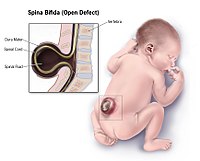
Photo from wikipedia
Neural tissue has high metabolic requirements. Following spinal cord injury (SCI), the damaged, tissue suffers from a severe metabolic impairment, which aggravates axonal degeneration and, neuronal loss. Impaired cellular energetic,… Click to show full abstract
Neural tissue has high metabolic requirements. Following spinal cord injury (SCI), the damaged, tissue suffers from a severe metabolic impairment, which aggravates axonal degeneration and, neuronal loss. Impaired cellular energetic, tricarboxylic acid (TCA) cycle and oxidative, phosphorylation metabolism in neuronal cells has been demonstrated to be a major cause of neural tissue death and regeneration failure following SCI. Therefore, rewiring the spinal cord cell metabolism may be an innovative therapeutic strategy for the treatment of SCI. In this study, we evaluated the therapeutic effect of the recovery of oxidative metabolism in a mouse model of severe contusive SCI. Oral administration of TCA cycle intermediates, co-factors, essential amino acids, and branched-chain amino acids was started 3 days post-injury and continued until the end of the experimental procedures. Metabolomic, immunohistological, and biochemical analyses were performed on the injured spinal cord sections. Administration of metabolic precursors enhanced spinal cord oxidative metabolism. In line with this metabolic shift, we observed the activation of the mTORC1 anabolic pathway, the increase in mitochondrial mass, and ROS defense which effectively prevented the injury-induced neural cell apoptosis in treated animals. Consistently, we found more choline acetyltransferase (ChAT)-expressing motor neurons and increased neurofilament positive corticospinal axons in the spinal cord parenchyma of the treated mice. Interestingly, oral administration of the metabolic precursors increased the number of activated microglia expressing the CD206 marker suggestive of a, pro-resolutive, M2-like phenotype. These molecular and histological modifications observed in treated animals ultimately led to a significant, although partial, improvement of the motor functions. Our data demonstrate that rewiring the cellular metabolism can represent an effective strategy to treat SCI.
Journal Title: Pharmacological research
Year Published: 2022
Link to full text (if available)
Share on Social Media: Sign Up to like & get
recommendations!